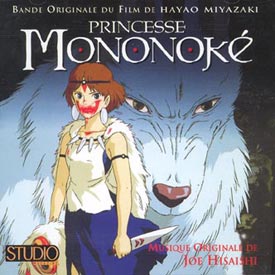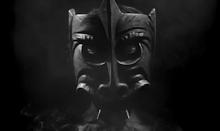(The twenty five is an examination of the twenty five films that made me a cinephile. These aren’t necessarily what I consider best movies, nor are they necessarily my favorite. Though in some cases they are both. Instead these are the films that made the biggest most indenialable impression on me. Films that if they hadn’t hit a certain way at a certain time I would not be the same film goer that I am today. They’re the twenty five.)
 For the record I’m reviewing the dub of Kiki’s Delivery Service. I’m normally a sub purist, but for Kiki I make an exception. It’s the one I was introduced to, the one I admittedly usually watch, and the one I always think of. I wouldn’t be fooling anyone if I did not admit that for me, Phil Hartman IS Gigi.)
For the record I’m reviewing the dub of Kiki’s Delivery Service. I’m normally a sub purist, but for Kiki I make an exception. It’s the one I was introduced to, the one I admittedly usually watch, and the one I always think of. I wouldn’t be fooling anyone if I did not admit that for me, Phil Hartman IS Gigi.)
There is some but not as much overlap as I expected between my favorite films of all time, and the most influential one’s I’m writing about.
Kiki’s Delivery Service is one of the few that makes both lists. The effect it had on how I view the movies, animation and the concept of narrative cannot be underestimated.
This might seem like an odd choice, as even fervent Miyaziki fans tend to dismiss
Kiki, writing it off as either the least of the masterpieces, or the best of the second tier. It's my personal favorite of his films.
I saw
Kiki’s Delivery Service around twelve, just at the time I was supposed to be outgrowing cartoons, let alone a cartoon about a cute Girl Witch. A notion I wasn’t all too eager to be dissuaded from.
Kiki did to my dismissal of animation and my ideas of what a story should be what the tollbooths did to James Caan in
The Godfather, shredded them beyond recognition.
Lets start with something that I don’t know if, my younger readers will be able to grasp, and that’s just how alien
Kiki’s Delivery Service looked at the time. Anime has been more or less utterly assimilated into American culture, you can find it in our advertising, movies, TV shows, and breakfast cereals. But back in 1997 it was still a genuine other. You have to remember this was when VIDEO Games where trying to make sure, that their covers didn’t look like anime. Think about that. They where afraid that nerds wouldn’t like anime. That’s how weirded out by this people where.

(So This...)

(Becomes This...)
Sure
Ghost In The Shell and
Akira had played in US theaters, but these where both unabashedly cult films and hadn’t really crossed over to the genuine public.
DBZ and
Sailor Moon where both on TV, but I didn’t have cable, and hadn’t seen either of those shows in more then an isolated clips.
Of course
Pokemon was only a few years away from rewiring everyone under the age of fourteen’s brain to accept anime as a set of aesthetics unquestionally, setting off the Manga Bubble. Soon
Princess Mononoke would pave the way for S
pirited Away’s theatrical run and Oscar win which was the first time that adult American film goers really had no choice but to pay attention to anime. But at the time I really can’t overstate how shockingly, entrancingly different from everything else
Kiki’s Delivery Service looked.
 Kiki’s Delivery Service
Kiki’s Delivery Service follows a young witch who according to her family’s tradition leaves home for a year to live and train on her own, Odd perhaps for a film, that features a talking cat and a zeppelin crash,
Kiki’s Delivery Service is a film I find so splendid for simply recording the day to day nature of life. Compared to the frenetic narratives of the film’s I’d been exposed to at the time (to say nothing of the down right spastic animated films I’d encountered)
Kiki is calm. There’s no manufactured crisis, save the crash at the end of that film and even that isn’t some world endangering disaster but simply treated as something bad that happens and is gotten through. A nasty accident and one of many we’ll encounter in life. Like the sickness before it, and the temporary loss of inspiration this too shall pass.
Think of the things that happen in
Kiki, the actual narrative events; Kiki makes a delivery, Kiki goes shopping, Kiki spends the night at a friends house, Kiki takes a bike ride down to the beach, Kiki buys household supplies, Kiki minds the bakery for a few hours, Kiki is nice to an old person and lets not forget Kiki accidentally stands someone up and then gets a cold. I like to think as he was reading that list Jeffery Katzenberg eyes began to bleed before he burst into flames.
And yet, never once does Kiki seem dull or ponderous. Far from the fantastical making the real world seem passé, Kiki takes the rhythms of every day life, and makes them magic. If Fellini ever directed a script by Ozu it’d probably go a little something like this. (Indeed one of my favorite little touches of the film is the way that Miyaziki sprinkles in Ozu like pillow shots throughout the movie. Unless I’m mistaken I don’t think it’s a technique that Miyaziki has used before, and it lends his film a subtly meditative air.

The film plays like a check list of the things that Miyaziki loves portrayed in their purest forms. Always a feminist friendly directed,
Kiki’s Delivery Service almost plays like 8 ½ without a deep abiding fear of women. The cast aside from Kiki’s geeky would be beau, is almost exclusively female and represent the various ages and stages of womanhood; from the independent artist Urusula, to domestic Goddess Osana, and the elderly graceful Madame. These are idealized women to be sure, but they are idealized in their intelligence and kindness.
The film is grandly humanistic as the best of Miyaziki. Miyaziki has always been one of the great compassionate directors, with the effect of his gentleness aided, not impaired by the skill with which he is able to render humanities flaws. In this film he does portray characters as selfish, and occasionally mean spirited. But he also gives them the benefit of the doubt. In one scene a posse of mean girls, who've been showing up in the periphery of the film, interrupt Kiki's and Tombo's day at the beach with an invitation to tour the zeppelin. When Kiki turns it down one of the girls says something nasty. We cut to the car, for just a second, long enough to let one of the girl's friends tell her off for her rudeness. Kiki doesn't hear the comment, it has no bearing on the story, it's there for our benefit alone. The message is clear, people as individuals are often better then we take them as when they're part of a group. There's a quick shot in the credits of Kiki and the girl chatting, having apparently developed a friendship. Its the kind of touch that only Miyaziki would take the time to put in. And its just another example of what makes him so invaluable as a filmmaker.

No less lovingly portrayed is Miyaziki’s other great love, flight. The film is more or less devoted to flight, and as far as I’m concerned it’s the zenith of his love affair with the subject. The independence of Kiki’s flight lends it an intimacy allowing us to rise above the city or zip between its corridors with her. It’s a tribute to all things that break the laws of gravity really, birds, planes, balloons, even the absurd Wright Brothers like contraption Tombo’s built.

It all takes place in the stunning ideal Europe that Miyaziki portrayed so effectively in this period. This Mixture of Mediterranean Elegance, Parisian Cosmopolitanism surrounded by miles of Pastoral Countryside, is perhaps Miyaziki’s purest expression of the “Europe Of The Mind” which has been his muse. And its rendered in loving detail. Miyaziki’s artistry is of course unsurpassed and while he has maybe made films that are more visually arresting, I don’t think he’s ever topped himself here for sheer level of loving detail put into his world. In every frame of the film there is some detail that didn’t need to be there, moss growing between the paving stones of a courtyard, a carving done on the edge of the fountain, the reflection of passersby on the shop's glass window, boats bobbing the background. The flakes of bread on the bakery floor, that make Miyaziki’s world come to life.
Kiki’s Delivery Service has been since I’ve seen it, and yet remains a tonic of a film for me. I refreshing reminder of the beauty of life and the greatness of art both in its themes and in and of itself.














































































































